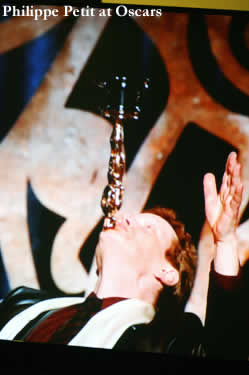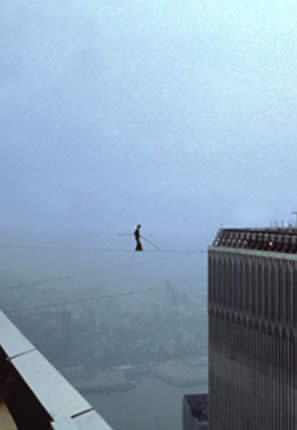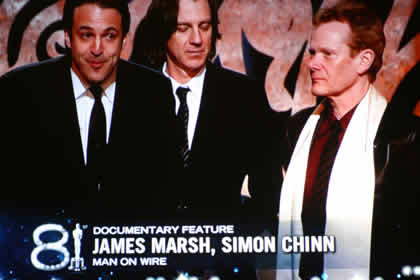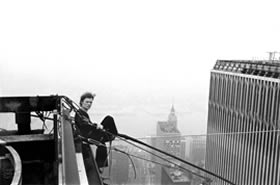Hollywood, California –
February 22, 2009 – Tonight Man ON Wire won the Best Documentary Feature Award at Academy Award Ceremony.
On August 7th 1974, a young Frenchman named Philippe Petit stepped out on a wire illegally rigged between New York’s twin towers, then the world’s tallest buildings. After nearly an hour dancing on the wire, he was arrested, taken for psychological evaluation, and brought to jail before he was finally released.
Following six and a half years of dreaming of the towers, Petit spent eight months in New York City planning the execution of the coup. Aided by a team of friends and accomplices, Petit was faced with numerous extraordinary challenges: he had to find a way to bypass the WTC’s security; smuggle the heavy steel cable and rigging equipment into the towers; pass the wire between the two rooftops; anchor the wire and tension it to withstand the winds and the swaying of the buildings. The rigging was done by night in complete secrecy. At 7:15 AM, Philippe took his first step on the high wire 1,350 feet above the sidewalks of Manhattan…
MAN ON WIRE is James Marsh’s third feature film. His breakthrough documentary, Troubleman, (1994) chronicled the last years of soul singer Marvin Gaye and his murder at the hands of his father, a fundamentalist preacher and occasional transvestite. This was followed by The Burger and the King (1996), a documentary about Elvis Presley’s bizarre eating habits. The Burger and the King garnered many awards, including Best Documentary from the Royal Television Society. In 1998, Marsh’s documentary profile of Velvet  Underground member John Cale earned Marsh a BAFTA award in Wales for Best Music Documentary.
Underground member John Cale earned Marsh a BAFTA award in Wales for Best Music Documentary.
Marsh’s first dramatic feature The King, was co-written with Oscar nominated screenwriter, Milo Addica. The King was an Official Selection at the Cannes Film Festival in 2005. In the summer of 2003, Marsh photographed, directed and edited the observational documentary, The Team, in collaboration with New York based filmmaker Basia Winograd.
Bijan Tehrani: When was your first encounter with this story? How did you decide to make this film?
James Marsh: I live in New York and have for many years, and Philippe is one of the modern day folk heroes of the city. The walk itself is part of the folklore of New York. I think a lot of people in New York have a dim awareness of it, and know the basic outline of the story. Philippe wrote a memoir, which is a very detailed account of how he did his walk. When I read that book, I thought there was a wonderful film to be made from this story. It became my duty to get this film underway, and I partnered with a producer in London who was already trying to do just that. I then had to meet Philippe and persuade him to trust me and give me his story. We agreed to collaborate on the telling of the story, and I wanted to really understand as much I could about the details of his point of view, and then build the film from that. I could then add the layers regarding the people involved in the plotting and execution of what is essentially a criminal conspiracy. However, their objective, while illegal, was not destructive or hateful.
BT: This is about the World Trade Center buildings. Did the events of 9-11 bring any doubts about how to approach this film?
JM: I am very over-familiar with the imagery of the destruction of those buildings. Everyone who watches the film will experience that to an extent. But my idea was to get people over those images very early. My first thought was to banish them from my thinking, and try to tell this gripping and beautiful story about these buildings. I think implicit in that is something very poignant. In practice, in the film, because Philippe conceived of his idea before they were even built, we were allowed to show the construction of the buildings. It was a very clear choice not to confuse these two events, and to tell Philippe’s story as best I could, and allow the audience to bring what they want to the film.
 BT: A lot of filmmakers who may have approached this subject would have made it strictly a first person story, from Philippe’s point of view. What was your reason for bringing other people to the story, and making it a story that is told from different points of view?
BT: A lot of filmmakers who may have approached this subject would have made it strictly a first person story, from Philippe’s point of view. What was your reason for bringing other people to the story, and making it a story that is told from different points of view?
JM: There is human drama in this story. It is a group of young fearless people who don’t know the rules. Philippe is foremost amongst them. It seemed to me that there was a very interesting set of relationships that was important to the execution of this event. It felt like a good idea to explore the other people involved, and to involve, for example, Philippe’s girlfriend at the time. It is wonderful to get five or six different versions of parallel, dissenting, and overlapping accounts, and to understand the wonderful and surprising set of personalities involved. They don’t really belong together. The first group of people is comprised of an American and an Australian while the rest are French. The final team is some dissolute, feckless Americans, who don’t believe in the team as much as the French team. It becomes this great human drama, and a comedy of errors fraught with tension and antagonism. It felt like the film opened up much more by having multiple perspectives on the events as opposed to just one single focus. I think it creates the comedy in the film, this unlikely blend of personalities.
BT: Like your other films, this film is muti-layered. It has different levels beside the surface story.
JM: Just by its very nature, yes. There is a kind of love story that is playing out as well. Through Philippe you see the woman who is in love with him. I think the film operates on a number of different levels. It is a fairy tale on one level; an impossible dream that is realized by force of will and passion. It is also a kind of thriller since a heist is being carried out. There are also elements of human drama and comedy. Of course there is the whole subtext of the tragedy of the towers that is lurking as well. I think you can also enjoy the film as a narrative for its own sake. Hopefully it is going to satisfy on that level. But yes, there are other ideas about the nature of art, performance, and beautiful for its own sake. There are those kinds of issues in the film that can make one pause and think, if one chooses to do so.
film operates on a number of different levels. It is a fairy tale on one level; an impossible dream that is realized by force of will and passion. It is also a kind of thriller since a heist is being carried out. There are also elements of human drama and comedy. Of course there is the whole subtext of the tragedy of the towers that is lurking as well. I think you can also enjoy the film as a narrative for its own sake. Hopefully it is going to satisfy on that level. But yes, there are other ideas about the nature of art, performance, and beautiful for its own sake. There are those kinds of issues in the film that can make one pause and think, if one chooses to do so.
BT: I enjoyed how the film is also about the joy of life. At a time when everyone is living in fear of terrorist acts, it brings such a brightness to life, and to the issue of braveness and attempting brave things.
JM: I think that is absolutely right. That is one of the reasons why I made the film. I saw it as a way to enjoy an adventure story, and to observe a group of people who broke through barriers, and wanted to create something beautiful. It is reckless and romantic. That was one of its appeals to me as a filmmaker. It has real joy to it. Other work I have done is not nearly as joyful or funny as this film. I think that is one reason why so far there has been a good response to it. It is very thrilling and joyful, but also subversive. It is against the law, what they do, but not wicked or mean. It shows the best of what people can do if they dream big.
BT: The character of Philippe is someone we are so close to. Of course no one can or will do what he did, but he makes us believe we could do something similar to what he does.
JM: It is an example for us all, I agree with you. The defining quality of Philippe is to not accept what seems impossible. Even when he fails at his first attempt, he doesn’t give up. What he is doing at a purely physical level seems impossible, but there is something in that which is inspiring. It is a lesson to learn, not to give up.
BT: How much did your other filmmaking experiences help you while making this film?
JM: Well, the film I made prior to this was a fictional film that I co-wrote, called “The King”. But the idea of film structure was useful to apply to this story, which was already written. The structure of the film is a heist film, as opposed to a more conventional documentary account of an event. That was something I got from making a feature film. So I was able to confidently make this film a heist film, even if it has the label of a documentary. It is a genre film. That came from making a fictional film. I made a film before that called “Wisconsin Death Trip”, in which I used elaborate black and white reconstructions. I finessed those even more in “Man on Wire” to be an efficient way of showing the story without it becoming a full-on dramatized feature film.
 BT: The segments of the film that show the construction of this plan by Philippe are very real. How did you manage to make those scenes so real?
BT: The segments of the film that show the construction of this plan by Philippe are very real. How did you manage to make those scenes so real?
JM: There wasn’t a lot of money to do it, so I just had to do choose the moments that I thought were most important, and worthy of the story. Each of the dramatizations is about overcoming obstacles—they have a clear dramatic premise. You are seeing things they have to overcome. You try to shoot those as suspensefully as you can, because they are dramatically pregnant ideas. These are all things that you don’t make up, but try to capture the dramatic idea of them, and present them as best you can with the resources you have so that they are dramatically viable in the film, as opposed to being boring illustrations. I wanted to make them feel like they had their own personality, and like they were bits of real movie making in the course of a documentary.
BT: Were you in consultation with Philippe while making this film?
JM: It was definitely a collaboration. Instructions were largely scripted by me. Philippe had different observations about the technicalities of what we were doing. I would take responsibility for those as being my filmmaking inventions. Some of my favorite parts of the film were Philippe himself reenacting events. Those are parts where I think the film works harmoniously.
BT: The interesting thing is that even though we know what happens, there is still a great deal of suspense.
JM: Exactly. And actually it had no right to happen. So many things could’ve gone wrong. As I worked through the story I was very mindful to really exploit these mishaps dramatically, because it was a wonderful story with all these setbacks. So hopefully that works for the audiences. Like many films of this nature, you are aware of the outcome, but the means by which he reaches this conclusion are absolutely mysterious, suspenseful, and baffling.
BT: What is your next project?
JM: I don’t really have one. I have another documentary that sounds preposterous. It is based on a dream diary; a diary that a man kept throughout his life. He recorded actual dreams he had about a woman he was in love with. I am trying to see whether I can develop a film – a kind of dreamumentary—around this love affair that is expressed through real dream stories. But trying to pitch that to a producer with money…it’s not an easy sell.

